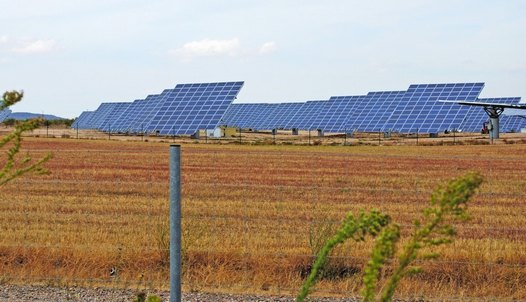The Autonomous Region of Navarra is located in northern Spain and has 578 210 inhabitants. Navarra can be characterised as a small, predominantly rural, region with only a few urban agglomerations and good access to natural assets. Economically, Navarra is committed to the growth of its industrial sector. Car manufacturing, machinery and equipment production have historically predominated.

Photovoltaic panels producing electricty in Navarra. Photo: Rasmus Ole Rasmussen.
Until 2003, Navarra was dependant on imported energy and the region has no traditional sources of primary energy. However by the end of 2008, 'renewables' provided 65% of the region's electricity consumption with wind power alone accounting for 70% of this.
A well established energy policy fully supported by the region's authority, the region's historical development of the industrial sector dominated by the automobile industry, and the active involvement of the private sector have all contributed to Navarra's renewable energy boom.
Initially, in the late 1980s, attention focused on the possibility of expanding hydroelectric power generation though this, ultimately, proved to be unworkable. In terms of wind power, the first pilot project was launched in the outskirts of Pamplona in 1994. The initiative came from the regional government and the Hydroelectric Energy Corporation of Navarra.
The first turbines in Navarra were provided by the Danish turbine manufacturer Vestas. This paved the way for the first factory making wind turbine components to operate in the region under a joint venture between Gamesa Eólica, Vestas and the Government of Navarra. By 2003, more than 50 companies were active in the renewable energy sector in Navarra.
The Regional Energy Plan 1995-2000 aimed to make Navarra the first region in Spain to become independent from foreign electricity supply, and to produce 100% of their electricity from renewable energy sources. Alongside direct investments made by the Government of Navarra private companies were granted direct subsidies for renewable energy development.
By 2009, 38 wind farms, with 1100 turbines, had been constructed in the region. A National Renewable Energies Centre (CENER) was established in 2000. The wind energy sector is today an exporting industry covering 16% of the global demand for wind turbines. Further, the development of wind energy has laid the basis for the development of solar power and bio-energy. At present, approximately 6 000 persons work in the renewable energy sector of which 4 200 are connected to the wind energy industry.